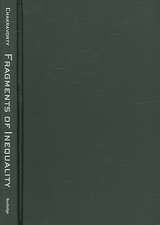Geographies of Rhythm: Nature, Place, Mobilities and Bodies
Editat de Tim Edensoren Limba Engleză Paperback – 30 noi 2016
| Toate formatele și edițiile | Preț | Express |
|---|---|---|
| Paperback (1) | 436.87 lei 6-8 săpt. | |
| Taylor & Francis – 30 noi 2016 | 436.87 lei 6-8 săpt. | |
| Hardback (1) | 1057.57 lei 6-8 săpt. | |
| Taylor & Francis – 28 feb 2010 | 1057.57 lei 6-8 săpt. |
Preț: 436.87 lei
Nou
Puncte Express: 655
Preț estimativ în valută:
83.60€ • 90.78$ • 70.23£
83.60€ • 90.78$ • 70.23£
Carte tipărită la comandă
Livrare economică 22 aprilie-06 mai
Preluare comenzi: 021 569.72.76
Specificații
ISBN-13: 9781138274549
ISBN-10: 1138274542
Pagini: 256
Dimensiuni: 156 x 234 x 22 mm
Greutate: 0.47 kg
Ediția:1
Editura: Taylor & Francis
Colecția Routledge
Locul publicării:Oxford, United Kingdom
ISBN-10: 1138274542
Pagini: 256
Dimensiuni: 156 x 234 x 22 mm
Greutate: 0.47 kg
Ediția:1
Editura: Taylor & Francis
Colecția Routledge
Locul publicării:Oxford, United Kingdom
Notă biografică
Dr Tim Edensor is Reader in Cultural Geography at the Department of Environmental and Geographical Sciences, Manchester Metropolitan University, Manchester, UK
Recenzii
'Geographies of Rhythm brings together fascinating contributions to the emerging field of rhythm analysis. Taking its starting point in Henri Lefebvre's inspiring but unfinished analysis, it works through concrete analyses to reach beyond his initial suggestions. The collection addresses a diverse range of issues, which are however connected in a common effort to show how places are always in a process of becoming but at the same time stabilised by repeated patterns of flow or rhythms. This should be a useful text for all those interested in the way in which rhythm analysis can advance the understanding of timespace, place and everyday life.' Kirsten Simonsen, Roskilde University, Denmark 'There is no doubt that the role of rhythm in the constitution and re-constitution of society is an under-explored facet of our existence. Taking off from Henri Lefebvre's suggestive essay on rhythmanalysis the chapters in this book go a long way to correcting this oversight. From horseriding to piloting planes, from city to the country, from interwar London to contemporary Santiago these smart and welcoming essays chart the role of rhythm in a diverse array of everyday lives. In doing so they bring rhythm right into the centre of an inter-disciplinary understanding of the mobilities of life. This book makes the project of rhythmanalysis a reality and it is sure to be a key reading for generations of scholars to come.' Tim Cresswell, Royal Holloway, University of London, UK 'Geographies of Rhythm mobilizes Henri Lefebvre's "rhythmanalysis" for the 21st century. Edensor and his contributors show how attention to the polyrhythmic quality of everyday life leads to a new approach to politics, aesthetics and ethics - and to a damning critique of economic rationality and utilitarian thinking and planning.' Rob Shields, University of Alberta, Canada
Cuprins
Chapter 1 Introduction: Thinking about Rhythm and Space, Tim Edensor; Part I Power and the Rhythms of Place; Chapter 2 Consuming Urban Rhythms: Let’s Ravalejar, Monica Degen; Chapter 3 Life Hacking and Everyday Rhythm, Tracey Potts; Chapter 4 The Aesthetics of Place-temporality in Everyday Urban Space: The Case of Fitzroy Square, Filipa Matos Wunderlich; Part II Resisting Rhythms; Chapter 5 Urban Outreach and the Polyrhythmic City, Tom Hall; Chapter 6 Fascinatin’ Rhythm(s): Polyrhythmia and the Syncopated Echoes of the Everyday, Deirdre Conlon; Chapter 7 ‘I’m in a Park and I’m Practically Dead’: Insomnia, Arrhythmia and Withnail and I, Craig Meadows; Part III Mobile Rhythms; Chapter 8 ‘He Who Thinks, in Modern Traffic, is Lost’: Automation and the Pedestrian Rhythms of Interwar London, Richard Hornsey; Chapter 9 Improvising Rhythms: Re-reading Urban Time and Space through Everyday Practices of Cycling, Justin Spinney; Chapter 10 Repetition and Difference: Rhythms and Mobile Place-making in Santiago de Chile, Paola Jiron; Chapter 11 ‘The Engine Sang an Even Song’: Rhythm and Mobilities among Early Women Aviators, Dydia DeLyser; Part IV Dressage and Bodies; Chapter 12 Rumba and Rhythmic ‘Natures’ in Cuba, Shannon Hensley; Chapter 13 Equine Beats: Unique Rhythms (and Floating Harmony) of Horses and Riders, Rhys Evans, Alexandra Franklin; partV Rhythms and Socio-Natures; Chapter 14 ‘The Breath of the Moon’: The Rhythmic and Affective Time-spaces of UK Tides, Owain Jones; Chapter 15 Re-thinking Catastrophe in the Timeof Climate Change, James Evans;
Descriere
In Rhythmanalysis, Henri Lefebvre put forward his ideas on the relationship between time and space, particularly how rhythms characterize space. Here, leading geographers are brought together to expand and advance on Lefebvre's theories, and to explore how they intersect with current theoretical and political concerns within the social sciences.




























